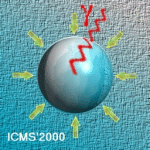
ICMS'2000
The International Conference on Multiphase Systems, ICMS'2000
Ufa, RUSSIA, June 15-17, 2000
Syunyaev R.
Russian State University of Oil and Gas named after I.M.Gubkin, Moscow, RUSSIA
The researches of structure of oil systems at the microscopic level are important for understanding and prognosis the behaviour of oil systems in oil recovery. Surface phenomena and disperse structure define their numerous macroscopic properties, such as viscosity, surface tension, aggregate stability etc. Oil systems present itself the colloidal-disperse objects with the low-polar dispersion media, but disperse phase includes the resin-asphaltene substances (RAS) or highmolecular alkanes. These components present itself natural unordered polymers of significant molecular mass. United exact chemical formula for resins or asphaltenes does not exist. The aggregation of asphaltenes is one of most significant factors, defining oil system behaviour in different processes of oil industry. Oil mixtures - complex dynamic systems, in which one and same molecules under different external environments and conditions can how to form disperse phase, so and be included in disperse media. Possible different types of associations are in consequence of differences of chemical nature of associating molecules. The structure of asphaltene molecules determines their increased ability to aggregation processes. They act as nuclei of the embryo when the oil dispersions are forming. Structural element is a dynamic complex structural unit, in which the sizes of component parts (nucleus, solvate shell) can change correlated to external factors.